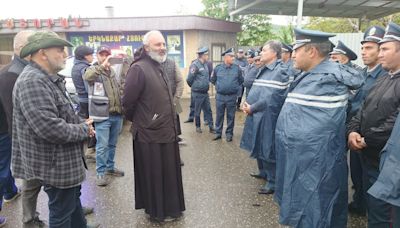Search results
Azerbaijan is a unitary semi-presidential republic. It is one of six independent Turkic states and an active member of the Organization of Turkic States and the TÜRKSOY community.
- Demographics of Azerbaijan
Population of Azerbaijan according to ethnic group...
- Azerbaijanis
Azerbaijan has benefited from the oil industry, but high...
- History of Azerbaijan
The history of Azerbaijan is understood as the history of...
- Emblem
The state emblem of Azerbaijan (Azerbaijani: Azərbaycan...
- Baku
Baku (US: / b ɑː ˈ k uː, ˈ b ɑː k uː /, UK: / b æ ˈ k uː, ˈ...
- Politics of Azerbaijan
The Politics of Azerbaijan take place in an authoritarian...
- Flag
The national flag of Azerbaijan (Azerbaijani: Azərbaycan...
- Maiden Tower
The Maiden Tower (Azerbaijani: Qız qalası) is a 12th-century...
- Boundaries Between The Continents
Similarly, according to this one particular definition,...
- Demographics of Azerbaijan
- Overview
- Relief, drainage, and soils
- Climate
- Plant and animal life
Azerbaijan, landlocked country of eastern Transcaucasia. Occupying an area that fringes the southern flanks of the Caucasus Mountains, it is bounded on the north by Russia, on the east by the Caspian Sea, on the south by Iran, on the west by Armenia, and on the northwest by Georgia. The exclave of Naxçıvan (Nakhichevan) is located southwest of Azerbaijan proper, bounded by Armenia, Iran, and Turkey. Azerbaijan includes within its borders the predominantly Armenian enclave of Nagorno-Karabakh, which from 1988 was the focus of intense conflict between Azerbaijan and Armenia. The capital of Azerbaijan is the ancient city of Baku (Bakı), whose harbor is the best on the Caspian Sea.
In addition to its variegated and often beautiful terrain, Azerbaijan offers a blend of traditions and modern development. The people of its remoter areas retain many distinctive folk traditions, but the lives of its inhabitants have been much influenced by accelerating modernization, characterized by industrialization, the development of power resources, and the growth of the cities, in which more than half the people now live. Industry dominates the economy, and more-diversified pursuits have supplemented the exploitation of oil, of which Azerbaijan was the world’s leading producer at the beginning of the 20th century. Fine horses and caviar continue as some of the more distinctive traditional exports of the republic.
As a result of its broken relief, drainage patterns, climatic differences, and sharply defined altitudinal zoning of vegetation, Azerbaijan is characterized by a wide variety of landscapes. More than two-fifths of its territory is taken up by lowlands, about half lies at 1,300 to 4,900 feet (400 to 1,500 meters), and areas above 4,900 feet occupy a little more than one-tenth of the total area.
Britannica Quiz
Guess the Country by Its Neighbors Quiz
The highest peaks are Bazardyuzyu (Bazardüzü; 14,652 feet [4,466 meters]), Shakhdag, and Tufan, all part of the Greater Caucasus range, the crest of which forms part of Azerbaijan’s northern boundary. Magnificent spurs and ridges, cut into by the deep gorges of mountain streams, make this part of Azerbaijan a region of great natural beauty. At the same time, it lies within a region characterized by a high degree of seismic activity.
The spurs of the Lesser Caucasus, in southwestern Azerbaijan, form the second important mountain system, which includes the Shakhdag, Murovdag, and Zangezur ranges, their summits rising to nearly 13,000 feet (4,000 meters), and also the Karabakh Upland. The large and scenic Lake Geygyol lies at an altitude of 5,138 feet (1,566 meters).
Are you a student? Get Britannica Premium for only 24.95 - a 67% discount!
The dry subtropical climate of central and eastern Azerbaijan is characterized by a mild winter and a long (four to five months) and very hot summer, with temperatures averaging about 81 °F (27 °C) and maximum temperatures reaching 109 °F (43 °C).
Southeastern Azerbaijan is characterized by a humid subtropical climate with the highest precipitation in the country, some 47 to 55 inches (1,200 to 1,400 mm) a year, most of it falling in the cold months.
Natural vegetation zones vary according to altitude. Steppe and semidesert conditions prevail in the lowlands and the foothills of the mountain regions. The slopes of the mountains are covered with beech, oak, and pine forests. Higher up there is a zone of alpine meadows. The Länkäran region of southern Azerbaijan has evergreen vegetation and thick beech and oak forests.
In the lowlands the animal life includes gazelles, jackals, and hyenas as well as reptile and rodent species. The mountain regions are inhabited by Caucasian deer, roe deer, wild boar, brown bear, lynx, European bison (wisent), chamois, and leopard, though the latter is rare. Mild winters draw many birds to the Caspian coast, and nature reserves provide a resting home for flamingos, swans, pelicans, herons, egrets, sandpipers, and partridges.
Azerbaijan (Azerbaijani: Azərbaycan; officially called the Republic of Azerbaijan) is a country in the South Caucasus region of Eurasia. It is next to Russia in the north, Georgia, Armenia in the west, Iran in the south, and Caspian Sea on the east. Its capital city is Baku.
Azerbaijan is a country in the Caucasus region, situated at the juncture of Eastern Europe and West Asia. Three physical features dominate Azerbaijan: the Caspian Sea, whose shoreline forms a natural boundary to the east; the Greater Caucasus mountain range to the north; and the extensive flatlands at the country's center. [1] .
- Ranked 112th
- Caspian Sea, −28 m (−92 ft)
Azerbaijan, officially Republic of Azerbaijan, Country, Transcaucasia, western Asia. Area: 33,436 sq mi (86,600 sq km). Population: (2024 est.) 10,210,000. Capital: Baku. Most residents are of Turkic origin, dating from the 11th century.
History of Azerbaijan, survey of events in eastern Transcaucasia from ancient times to the present with a focus on the modern state of Azerbaijan.
People also ask
Where is Azerbaijan located?
What is Azerbaijan known for?
Why was the name Azerbaijan chosen?
When did Baku become the capital of Azerbaijan?


